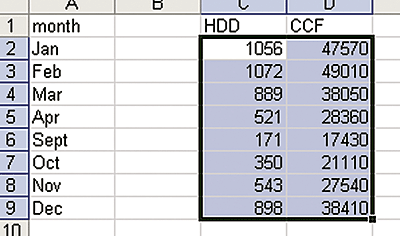
When a new hospital in New England opened, it expected about 5,000 heating degree-days (HDD), based on the weather bureau's 30-year average. But its first winter was exceptionally cold, with 5,500 HDD during the eight-month winter period. The facility manager noted that he used 267,480 CCF of natural gas during those winter months, so he figures he did so at a rate of 48.6 CCF/HDD (i.e., 267,480 CCF/5500 HDD). Based on this factor, he calculates that a normal 5,000-HDD winter would require that he burn 48.63 x 5000 = 243,150 CCF.
What's wrong with this method?
Don't Forget Base Usage
If, indeed all heating fuel was used solely to counter exterior temperatures, that method should provide a reasonably good answer. Unfortunately, many facilities also consume gas in heating line distribution losses, steam leaks, boiler pilot lights, and domestic hot water.
In the case of the hospital in question, fuel is also used to make steam for sterilizers, prepare food in the cafeteria, and keep a therapeutic swimming pool warm. To properly correct for weather variations, the relatively constant monthly usage of fuel for these other systems must be taken into account.

Regression To The Rescue
We may better determine the relationship between monthly fuel usage and HDD by using Microsoft Excel™ to chart it. Set up a table of monthly data (Figure 1) and highlight the two columns containing your consumption and HDD data. Use Excel's Chart Wizard and (under "Standard Types") choose "XY (Scatter)."Once the chart has been created (Figure 2), click on the "Chart" command (not the Chart Wizard) and "Add Trendline." Under the "Type" tab, choose "Linear." Under the "Options" tab, check off both "Display equation on chart" and "Display R-squared value on chart."
Excel then draws a best-fit trendline for your data points, calculates a linear mathematical formula, and provides an R2 value (indicating how well the formula fits the data). An R2 of 1.0 is perfect, but most of us are happy when it's .7 or higher. In our example, the data fits rather well, making R2 = .976.
The formula of 34.215 X + 9912.2 means that 34.215 (not 48.63) CCF are consumed for each HDD, and 9,912.2 CCF/month are used regardless of the temperature. If we extend the trendline back to zero HDD (see dashed line), it would cross at 9,912.2. To highlight the flat consumption and extend the trendline, we added the cross-hatched area and dashed line using Excel's "Draw" commands.
Using The Formula To Better
Predict Fuel Consumption Using his simple factor of 48.63 CCF/HDD, our facility manager concluded a normal 5,000 HDD winter would consume 243,150 CCF. Using our more precise formula, we instead come up with 250,373 CCF (over 7,200 CCF higher). That's because the flat usage of almost 10,000 CCF per month (which accounts for almost 32% of his winter consumption) occurs regardless of outdoor temperature. Had it been higher, the facility manager's overly simple method would have further underestimated winter fuel usage.For those buying heating fuel through a third-party marketer, usage above an agreed-upon level may be charged not at the contract rate, but at the spot market rate (which could be considerably higher), so it pays to be as accurate as possible when forecast usage. ES



